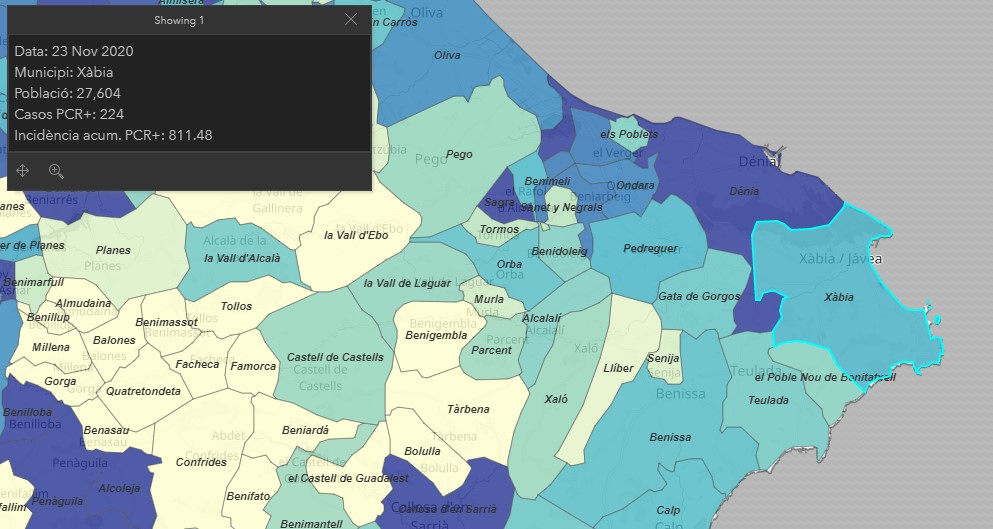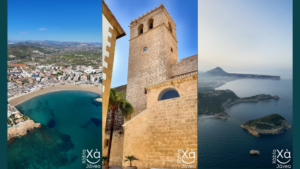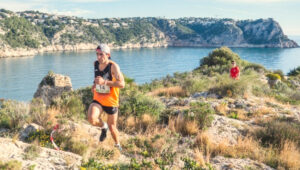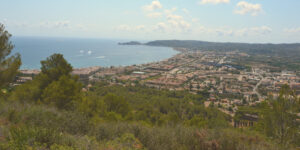Xàbia records no new infections; Marina Alta sees smallest rise for a month
Xàbia’s data appears to have been re-adjusted so that the municipality actually has one LESS infection since the crisis began in March.

Xàbia
The latest data released by the Ministry of Health in the Comunidad Valenciana shows that Xàbia has recorded no new infections since the last update and that the total number of infections has in fact DROPPED to 224 since the crisis began; the reason for this reduction is not clear and will be confirmed as soon as possible.
The 14-day cumulative rate (IA) has also dropped, now standing at 57.96 new infections per 100,000. The death toll remains at 3.
Marina Alta
The Dénia Health Authority, which covers almost all of the Marina Alta region, has recorded 18 new infections since the last update bringing the total to 1,881 positive cases since the crisis began. This represents the lowest rise in new cases since mid-October.
However, the latest data has showed that four municipalities have had their total infections REDUCED by one each: Xàbia, Dénia, Ondara and Els Poblets. The reason for this reduction is not clear and will be confirmed as soon as possible.
The 14-day IA rate has dropped to 78.61 new infections per 100,000 inhabitants, the lowest since the end of October. The rate has dropped by 37% in 14 days and remains one of the lowest rates in the whole Comunidad Valenciana, only improved on by La Marina Baixa (58.82).
The death toll in the Marina Alta climbs one to 35 after El Verger recorded its first fatality from COVID-19.
The new infections have been recorded in the following municipalities:
- Benissa – 4
- Pedreguer – 4
- Calp – 3
- Gata de Gorgos – 2
- Teulada – 2
- El Verger – 1
- Llíber – 1 *
- Orba – 1
* Llíber has recorded its first infection.
Comunidad Valenciana
The 14-day IA rate has dropped to 265.34 new infections in 14 days per 100,000 inhabitants, the lowest figure since November 9th and the Comunidad Valenciana has taken back its crown as the autonomous region with the lowest rate in mainland Spain.
In the latest report published by the regional health authorities, 19 of the 25 health departments recorded drops in their 14-day IA rates. Of those which have seen an increase in their rates, Sant Joan d’Alacant has seen the greatest rise of over 20% since the last update whilst Elx-Crevillent is not far behind with a 14.32% increase. At the other end of the scale, Orihuela saw its rate drop by over 28% over the weekend, with both Vinarós and La Ribera close behind with decreases of just over 24% each.
The Generalitat Valenciana has announced that it will be distributing 8,000 devices with filters to purify the air and prevent the spread of coronavirus in classrooms that don’t have natural ventilation. The machines will filter the air continuously for between three-five minutes between classes.
Spain
The national 14-day IA rate has continues to drop for the tenth successive report and now stands at 374.52 new infections in 14 days per 100,000 inhabitants, the lowest figure since October 23rd. All 17 autonomous regions and both autonomous cities of Melilla and Ceuta saw their IA rates drop over the weekend. Data confirms that the ‘second wave’ of infections appears to have peaked nationally on November 4th.
The region of Navarra has been particularly successful in bending the curve, recording at 61% drop in their IA rate in 14 days, whilst Cataluña has seen their rate drop by half in the past two weeks, and this week some restrictions have been lifted, including the re-opening of bars and restaurants, albeit only until 9.30pm.
Prime Minister Pedro Sánchez has announced that the nation’s vaccination campaign could begin as early as January, with medical professionals and senior citizens among the first to receive the jabs, along with the chronically ill and high-risk people with pre-existing conditions. Spain’s primary healthcare network is one of the most efficient methods to deliver the vaccine and already more than 14 million people have received flu jabs in just eight weeks this autumn.
In a TV address to the nation, Sánchez also admitted that Christmas is going to be different this year: “We are going to have to stay at a distance from our loved ones instead of hugging them”, warning that the priority “must be to avoid a third wave”.
The following day, El Pais reported that the government was looking at limiting family and other social gatherings over the Christmas period to six people (with the exception of those who live in the same household), whilst relaxing the night-time curfew to 1.00am for Christmas Eve and New Year’s Eve. The draft document also recommended that the traditional Three Kings’ parades not take place given the ‘elevated risk of transmission due to the high number of spectators, the intensity of contact and the difficulty of mitigating the associated risks’.
In Madrid, the famous El Rastro Sunday market has re-opened after 37 weeks, albeit with half the number of stalls and drones monitoring capacity, which has been set at 2,702 people.
COVID-19 C.Valenciana: Monitorage de la Situació
Ministero de Sanidad: Actualización nº 256 (23/11/2020)
El Pais
Tuesday 24th November, 12.30pm – MGS



